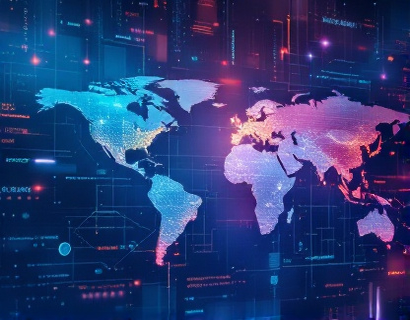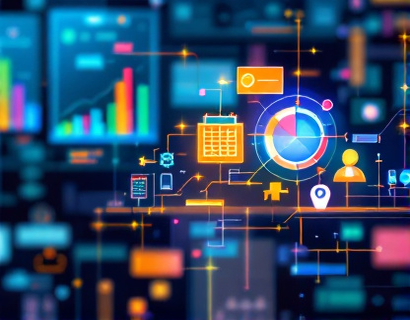Maximizing Global Connectivity: Innovative Distributed Network Solutions for Enhanced Efficiency and Security
The landscape of global connectivity is undergoing a transformative shift, driven by the need for faster, more secure, and efficient data transmission. This evolution is pivotal for businesses and tech leaders aiming to stay competitive in the digital age. The advent of innovative distributed network solutions marks a significant milestone in this journey, offering a redefined approach to connectivity that promises unparalleled efficiency, robust security, and advanced resources. This article delves into the intricacies of these cutting-edge technologies, exploring how they are reshaping the future of digital collaboration and growth.
Understanding Distributed Networks
Distributed networks are systems where components or nodes are spread across various locations, interconnected to work together as a cohesive unit. Unlike traditional centralized networks, distributed networks do not rely on a single point of control or failure, which enhances their resilience and scalability. Each node in a distributed network can operate independently, yet collaboratively, to perform tasks, share resources, and process data. This architecture is fundamental to the next generation of global connectivity solutions.
Enhanced Efficiency Through Distributed Networks
One of the most compelling advantages of distributed networks is their ability to significantly enhance efficiency. By distributing tasks and data across multiple nodes, these networks can process information faster and more effectively. This parallel processing capability reduces latency and increases throughput, allowing for real-time data analysis and decision-making. For businesses, this means faster response times, improved operational efficiency, and the ability to handle large volumes of data seamlessly.
Moreover, distributed networks optimize resource utilization. Each node can contribute its computational power and storage capacity, creating a pool of resources that can be dynamically allocated based on demand. This not only maximizes the use of available resources but also reduces the need for expensive hardware upgrades. For organizations, this translates to cost savings and a more sustainable IT infrastructure.
Robust Security Features
Security is a paramount concern in the realm of global connectivity. Distributed networks offer a multi-layered approach to security, making them inherently more resilient against cyber threats. Since data is spread across multiple nodes, the risk of a single point of failure is minimized. Even if one node is compromised, the integrity of the entire network remains intact, as the data is replicated and distributed across other nodes.
Additionally, distributed networks employ advanced cryptographic techniques and consensus algorithms to ensure data integrity and confidentiality. These mechanisms make it extremely difficult for unauthorized entities to intercept or alter data. The decentralized nature of these networks also makes them less attractive targets for cyberattacks, as there is no central hub to exploit.
Innovative Technologies in Distributed Networks
The development of distributed networks has been propelled by several innovative technologies, each contributing to their enhanced capabilities. Blockchain technology, for instance, plays a crucial role in ensuring transparency and security. By using blockchain, distributed networks can maintain an immutable ledger of transactions, providing a tamper-proof record that enhances trust and accountability.
Another key technology is edge computing, which brings data processing closer to the source of data generation. This reduces the distance data needs to travel, further decreasing latency and improving response times. Edge computing, when combined with distributed networks, creates a powerful synergy that enhances both efficiency and security.
Artificial intelligence and machine learning are also integral to the evolution of distributed networks. These technologies enable predictive analytics, automated threat detection, and intelligent resource management. AI-driven algorithms can analyze vast amounts of data in real-time, identifying patterns and anomalies that human analysts might miss. This not only improves security but also optimizes network performance by dynamically adjusting resource allocation based on current needs.
Case Studies and Real-World Applications
The benefits of distributed networks are not theoretical; they are being realized in various industries through practical applications. In the financial sector, distributed networks are used for secure and efficient cross-border transactions, reducing the time and cost associated with traditional banking systems. The healthcare industry leverages these networks for secure sharing of patient data across different facilities, ensuring timely and accurate medical care.
In the realm of Internet of Things (IoT), distributed networks provide the necessary infrastructure to manage and process the massive amounts of data generated by connected devices. This enables smart cities to optimize traffic flow, energy consumption, and public safety, creating more livable and efficient urban environments.
For tech companies, distributed networks offer a scalable and flexible platform for cloud services, enabling them to deliver high-performance applications with minimal downtime. This is particularly beneficial for global enterprises that require robust and reliable connectivity across multiple regions.
Challenges and Considerations
While the advantages of distributed networks are clear, there are also challenges and considerations that organizations must address. One of the primary challenges is the complexity of implementing and managing a distributed network. This requires a skilled workforce capable of designing, deploying, and maintaining the infrastructure. Additionally, ensuring interoperability between different nodes and systems can be a complex task.
Another consideration is the initial investment required to transition from traditional networks to distributed networks. While the long-term benefits often outweigh the initial costs, the upfront expenses can be significant. Organizations must carefully evaluate their ROI and plan accordingly to ensure a smooth transition.
Privacy concerns also arise in distributed networks, particularly when sensitive data is involved. While the decentralized nature enhances security, it is crucial to implement stringent privacy measures to protect user data. Compliance with data protection regulations, such as GDPR, is essential to maintain trust and avoid legal repercussions.
Future Prospects and Trends
The future of distributed networks looks promising, with several trends and advancements on the horizon. One such trend is the integration of 5G and beyond, which will further enhance the speed and reliability of distributed networks. The increased bandwidth and reduced latency of 5G will enable more sophisticated applications and services, opening new possibilities for industries such as augmented reality, virtual reality, and autonomous vehicles.
Another exciting development is the rise of decentralized finance (DeFi) and decentralized applications (dApps), which leverage distributed networks to create financial systems and applications that are transparent, secure, and accessible to everyone. These innovations have the potential to democratize finance and empower individuals and businesses alike.
Furthermore, the convergence of distributed networks with quantum computing holds immense potential. Quantum computing can solve complex problems that are currently infeasible for classical computers, and when combined with distributed networks, it can revolutionize fields such as cryptography, optimization, and simulation.
Conclusion
The evolution of global connectivity through innovative distributed network solutions represents a significant leap forward in efficiency, security, and resource management. These networks offer a robust and scalable infrastructure that can support the growing demands of businesses and tech leaders in the digital age. By embracing these technologies, organizations can drive digital success, foster collaboration, and stay ahead of the curve in an increasingly interconnected world.










































